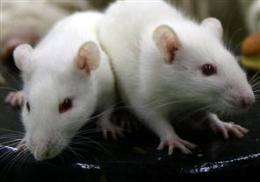Huddling rats behave as a 'super-organism'

Rodents huddle together when it is cold, they separate when it is warm, and at moderate temperatures they cycle between the warm center and the cold edges of the group. In a new study published in PLOS Computational Biology, Jonathan Glancy, Roderich Gross, Jim Stone and Stuart Wilson from the University of Sheffield found they could simulate huddling by assuming simply that touching individuals in turn brings their temperatures closer to an ideal body temperature. According to the model, these selfish individual behaviours improved the ability of the whole group to regulate its temperature.
The equations of the model suggest that the huddle behaves like a 'super-organism', as if it were one larger animal able to change its shape to retain its heat. This allows the group to better adapt to changes in the outside temperature. Lead author Jonathan Glancy explains "Our model describes the huddle as a self-organising system, and reveals how complex group behaviors can emerge from very simple interactions between animals".
Huddling is an important example of a self-organising behaviour with a clear evolutionary advantage, because animals that can coordinate their movements to keep warm are more likely to survive. A surprising prediction of the study is that effective huddles can only self-organise when individuals contribute some of their own heat for the greater good of the group. Moreover, the model predicts that the ability of individuals to thermoregulate might actually disrupt huddling. Future experiments can therefore test the accuracy of the model, and shed light on how evolution might take advantage of useful tricks like huddling.
This work is part of an ongoing collaboration between the department of Psychology and Sheffield Robotics, and the researchers are now interested to see whether their huddling equations could be used to coordinate movement patterns in teams of cooperating robots, or perhaps even 'biohybrid' teams of robots and animals.
More information: Glancy J, Groß R, Stone JV, Wilson SP (2015) A Self-Organising Model of Thermoregulatory Huddling. PLoS Comput Biol 11(9): e1004283.DOI: 10.1371/journal.pcbi.1004283
Journal information: PLoS Computational Biology
Provided by Public Library of Science



















